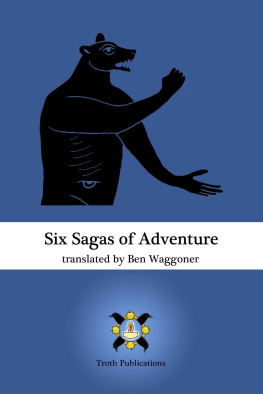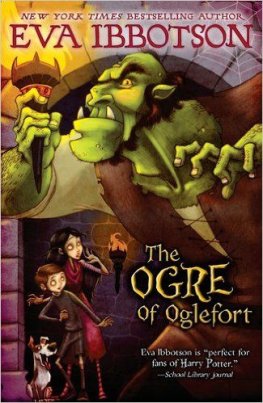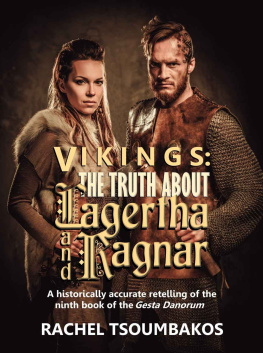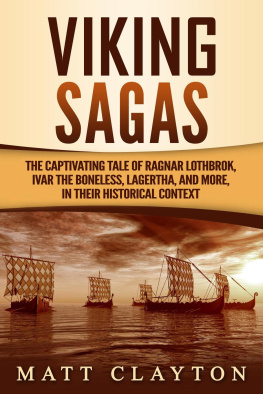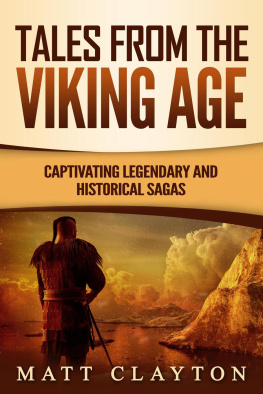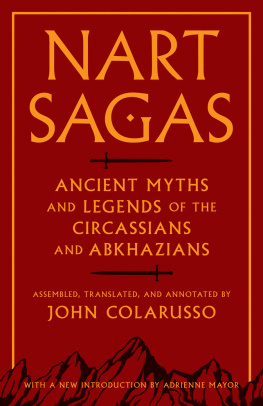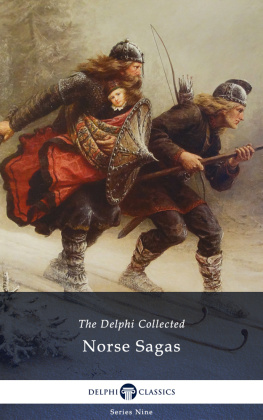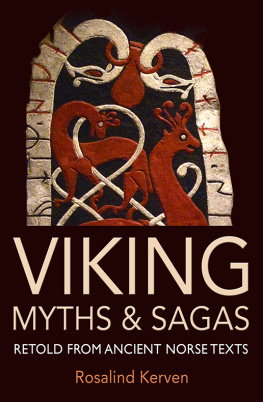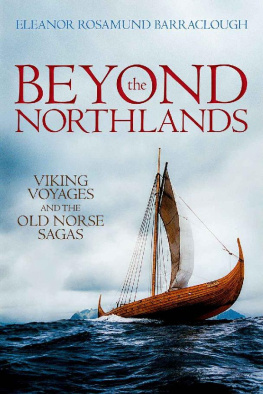SIX SAGAS OF ADVENTURE
translated by Ben Waggoner
Troth Publications
2014
2014, The Troth. All rights reserved. No part of this book may be reproduced or transmitted in any form or by any means, electronic or mechanical, including photocopy, recording, or any information storage and retrieval system, without prior permission in writing from the publisher. Exceptions may be allowed for non-commercial fair use, for the purposes of news reporting, criticism, comment, scholarship, research, or teaching.
A portion of an earlier version of The Saga of King Gautrek was previously published in The Sagas of Fridthjof the Bold (Troth Publications, 2009; ISBN 978-0557240203).
An earlier version of The Saga of Sturlaug the Hard-Working was previously published privately by Troth Publications.
An earlier version of The Saga of Hromund Gripsson was previously published in e-book editions by Troth Publications.
Published by The Troth
24 Dixwell Avenue, Suite 124
New Haven, Connecticut 06511
http://www.thetroth.org/
ISBN-13: 978-1-941136-04-1 (print), 978-1-941136-05-8 (e-book)
Cover emblem: A cynocephalus from the Arnstein Bible (British Library BL Harley 2799), written ca. 1172.
http://www.bl.uk/catalogues/illuminatedmanuscripts/record.asp?MSID=7862&CollID=8&NStart=2799
Troth logo designed by Kveldulf Gundarsson, drawn by 13 Labs, Chicago, Illinois
Cover design: Ben Waggoner
To my sister,
teller of sagas and tales
me alls konar strengleika
And in memory of my grandmother,
kvenna vitrust ok vnust
Table of Contents
INTRODUCTION
There was once a tendency for outsiders to view Iceland as a sort of cold-storage facility, where the ancient lore of the pre-Christian Germanic peoples had been perfectly preserved. Jacob Grimm had written in Teutonic Mythology that we find a purer authority for the Norse religion preserved for us in the remotest corner of the North, whither it had fled as it were for more perfect safety, namely, in Iceland.
Its quite true that the written Icelandic language has changed relatively little in the past millennium. Modern Icelanders can read their sagas, at least with the spelling normalized, far more easily than most English speakers can read English texts of about the same age, such as Sir Gawain and the Green Knight or Ayenbite of Inwyt . Its also true that by far the largest corpus of myths and legends of any Germanic-speaking people has been preserved in Iceland. For a number of reasons, generations of Icelanders wrote, copied, and studied prose and poetry containing myths, legends, and history, even into the early 20 th centuryand some of what they copied almost certainly does go back to pre-Christian times. But to call that literary record pure is completely wrong.
By tradition, Iceland adopted Christianity as its official religion in the year 1000. At the time, variants of the rune writing system had been in use for centuries, and would continue to be used for centuries afterwardsbut the rune alphabet had never been used to record lengthy texts. Christianity brought the Latin language and literature, the churchs educational system, and manuscript culture to Iceland. In turn, literacy in Latin and exchange with the European continent gave educated Icelanders access to medieval literary culture, both Christian and secular. By the mid-13 th century, the earlier sagas of Icelanders and kings sagas were being written to recount the histories of the Scandinavian royal families and the early settlers of Iceland. At the same time, clergymen at the Norwegian royal court were translating romances of Tristan and Charlemagne and King Arthurs knights. Foreign missionaries came to teach and preach in Iceland; Icelanders traveled to the Norwegian court, or went on pilgrimages to Rome or Jerusalem or other holy sites; and Icelandic priests studied in continental monasteries and universities. All of these travelers brought books of sermons, moral tales, learned treatises, classical texts, and chivalric romances with them. Presumably, they heard and told oral stories as well, whether their own adventures or tales that they had picked up. All of these influences can be traced in the sagas composed in Iceland, mingling with what must have been a strong native tradition of stories and poems.
The six sagas in this book are traditionally considered fornaldarsgur , legendary sagas or sagas of ancient times. This is not a name that medieval Icelanders used: the group was named and defined when Carl Christian Rafn published a collection of sagas under that name in 1829-30. Several others were later added to what has become a traditional fornaldarsgur canon of thirty-three sagas and tales. The fornaldarsgur are primarily set in Scandinavia (although with frequent excursions to the British Isles, continental Europe, Africa, Arabia, India, or realms not found on modern maps). Most are set in a rather nebulous past, and they deal with larger-than-life kings and heroes. Aside from that, they are a very diverse group, and there has been some controversy over whether the fornaldarsgur can be called a genre, and if so, how best to define it. Yet this definition still encompasses sagas in multiple literary modes. Even a single saga may switch from, say, the heroic mode to a wonder-tale, or from tragedy to comedy, or from archaic legends to the world of medieval chivalry.
Its common to divide the fornaldarsgur into three main typeswith the caveat that many sagas blur the distinctions between types, or contain elements of more than one. Viking sagas or Wikingersagas often contain old poetry as well, but they generally lack the tragic sense of the heroic sagas. They are generally set in or just before the historical Viking age, and the milieu is typically Viking, with plenty of battles on sea and land, quests for marvelous treasures, and assorted adventures leading up to a triumphant climax. Ragnars saga lobrkar is perhaps the best-known Viking saga; the Hrafnista saga cycle, whose best-known member is rvar-Odds saga , is also typical of the type.
The third class of fornaldarsgur , the adventure tales or Abenteuersagas , have neither deep legendary roots nor an especially historical setting. An adventure tale might have characters who are the very models of Viking heroes, and plenty of Viking color such as dragons, dragon ships, hoards of gold, and so onbut these sagas were created after the Viking Age was a distant memory. There is generally no poetry in these sagas, or at most a few isolated stanzas ( lausavsur ), and the action spans a single generation, although the heros father and/or sons may have supporting roles. On the other hand, there is a great proliferation of motifs from folk and fairy tales. The adventure tale hero may or may not be of noble birth, but he is generally either a splendid paragon of all manly virtues, or a coal-biter who does nothing but lounge by the fire. In either case, some danger or villainy forces the hero to set out on a quest, where he will face many foes and perils, but also get help from uncanny beings such as giants, dwarves, and/or witchy old crones. He will also make human allies (whom he often has to fight before they end up allying with him). The hero may win his first great conflictthe first pivotbut then have to rest and be healed, go off on a side adventure, or discover that his victory was not complete: there is still a greater deed that must be done or a greater prize to be won. These will lead him by various narrative twists and turns to the second pivot, usually a colossal battle. The happy ending has the hero winning great wealth, a kingdom to rule, a friendly reconciliation with any surviving enemies, and a long-awaited marriage to a beautiful and wise princess. The happy couples descendants may be enumerated at length; some of these may figure in other legendary sagas, or else their lineage may be traced to a royal house of Norway or to a prominent Icelandic family. Or the saga may simply state that many famous men are descended from them.

